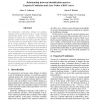Free Online Productivity Tools
i2Speak
i2Symbol
i2OCR
iTex2Img
iWeb2Print
iWeb2Shot
i2Type
iPdf2Split
iPdf2Merge
i2Bopomofo
i2Arabic
i2Style
i2Image
i2PDF
iLatex2Rtf
Sci2ools
84
Voted
ICPR
2002
IEEE
2002
IEEE
Relationship between Identification Metrics: Expected Confusion and Area Under a ROC Curve
The mathematical relationship between the expectedconfusion metric and the area under a receiver operating characteristic (ROC) curve is derived. Given a limited database of subjects and an identification technique that generates a feature vector per subject, expected confusion is used to predict how well the feature vector will filter identity in a larger population. Related is the area under a ROC curve that can be used to determine the probability of correctly discriminating between subjects given the feature vector. These two measures have different connotations, but we show mathematically and verify experimentally that a simple transformation can be applied to the expected confusion to find the probability of incorrectly discriminating between subjects, which is the complement of the area under a ROC curve. Furthermore, we show that as a function of the number of subjects, this transformed expected-confusion measure converges more quickly than direct calculation of the area under...
| Added | 09 Nov 2009 |
| Updated | 09 Nov 2009 |
| Type | Conference |
| Year | 2002 |
| Where | ICPR |
| Authors | Amos Y. Johnson, Aaron F. Bobick |
Comments (0)

